Cuts and fills are essential railroad right-of-way engineering. Without fills tracks crossing uneven or hilly terrain as shown here would require mile upon mile of costly bridge, trestle and other structural work. Fills eliminate these expensive to build and maintain elements. However, fills are also complicated structures having their own construction principles and guidelines to ensure stability. It’s hardly as simple as piling up a bunch of dirt or rocks and laying track on top.
The fill shown in these first two photos illustrates several important features modelers might want to pay closer attention to. First, although I’m hardly a structural engineer, I suspect that the material used here is a mix of different size rock, with fines and other granular material that allows for compaction. This is important for the stability of the track and traffic it carries. This right of way dates back to the steam era and I suspect this fill has been re-engineered somewhat to carry modern loads (that’s speculation on my part). Notice how much slope there is to the material. This is called the angle of repose, an angle at which a given material will naturally come to rest and be stable. (Correct me as needed Will.)
You’ll also notice the railroad has cleared trees and other brush away from the tracks. They’ve done this along much of the line this year. It has been a very dry summer for this region in 2012 and preventing brush fires may have also been a consideration in clearing away encroaching vegetation. Looking in the opposite direction in the photo below, you can see the scars from construction equipment and other work performed in this area. Take note of the washed stone that was brought in as a paving surface keep equipment out of the mud. Notice how rough the foreground is and the mix of live and dead vegetation compared to the area in the distance.
In this photo below take note of how deep the ballast is and how generous the ballast shoulder is. You can see what looks like a bit of dirt peeking through in the foreground. Probably a result of all the work in the area.
Finally, looking west again, you see how shallow the slope of the bank is compared to the near vertical cliffs typically modeled because we don’t leave enough space to do it right. You can also see how much brush and debris remains from the clean-up efforts. Observe how the base material was formed into a pad for the crossing flashers and the ever present drainage path for water runoff. The road crosses the track at an angle and the crossing protection is aligned for the motorist’s visibility. Observant eyes will also detect how the original terrain contours flow from one side of the road to the other. You’ll also notice how far back the utility poles are from the track.
And last, but certainly not least, the track has a distinct tinge of color from the oil and grease drippings of many passing trains. All of these features and more, are easily modeled once you know they are there.
Regards,
Mike
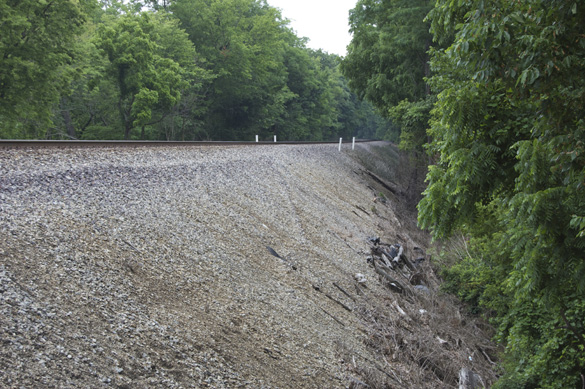
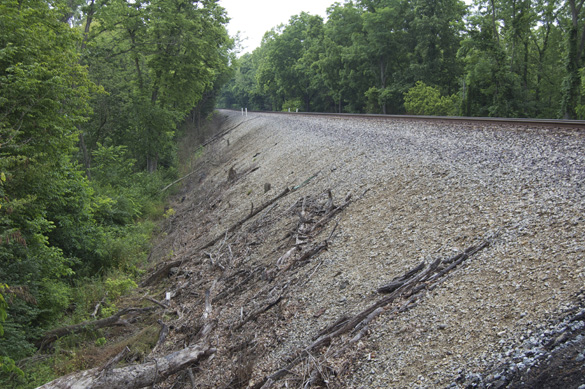
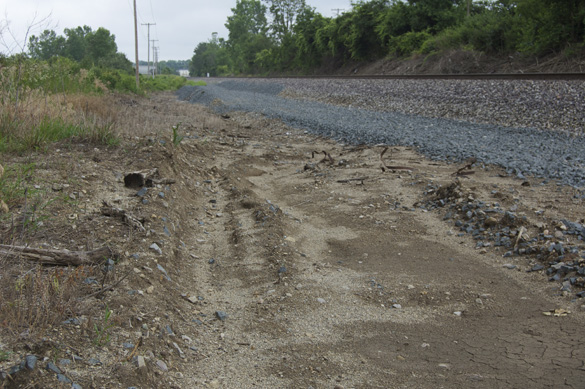
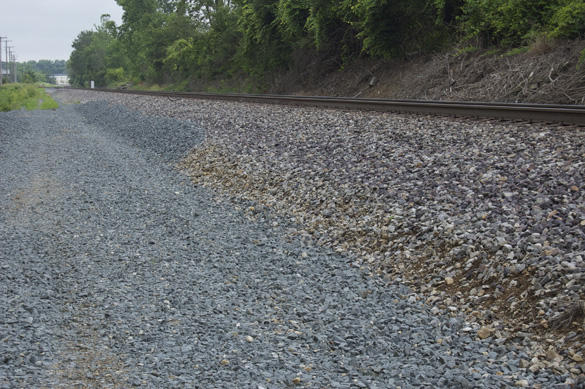
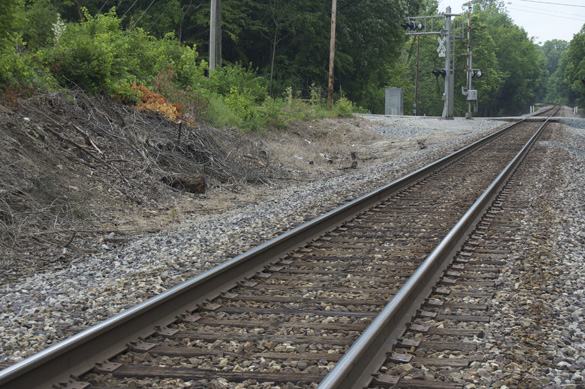
I know you’re focusing on the micro, but the macro view is that the track doesn’t disappear into an “urban canyon” or a tunnel, but between trees. In Maine this will be the case in the vast majority of cases. A scale or near scale sized tree is a far more imposing structure than a drug store, and takes more time to model when done well. I beleive that the context of a train is far more important than the trains themselves to a non-train viewer. They may not know what a X29 box car is, but everyone has seen buildings, trees, and fields.
By the way, nearly all fills in Maine started life as wooden trestles. They were filled in over time, generally using bank gravel filled gondolas both filled and emptied with shovels. It would be an interesting scene to model, and a great source of traffic.
Hi Ed,
Quite correct on all counts. Trees are a misunderstood and under used scenic element in most modeling scales. As you’ve seen on Trevor Marshall’s blog, they can make a stunning scene when used well. Your comments about the context being more relevant to non modelers is spot on.
I suspect that the majority of railroad fills started as trestle work. I’ve seen numerous vintage photos of the transcontinental railroad that used exactly this type of construction. My guess would be it was a common practice.
Thanks for writing in. Glad you’re here.
Regards,
Mike
Mike,
Very good information here! This is one aspect of modeling that can really make or break a model railroad. How often do you really see a perfectly flat area for the ROW? Almost never, unless you are in the Plains somewhere. But even there some grading will have to be done. It all comes down to one thing: Drainage! While you are building your model railroad try to think about where water would go and that can really help you see prototypical grading situations. If you have a low spot you are either going to have to bridge it or fill it and if you fill it you will have water draining down either side of the tracks. You dont want the water to just sit on the back side of the fill so you must put in a culvert for the water to escape under your fill. Culverts are really neat and easy to model, you will find them all over the railroad!
Most fills like you said are made up of just compacted fill-dirt. If you are lucky you can get it from a cut that you had to make up the line. Fill-dirt is full of everything you could ever think is underground; roots, rocks, rubble, clay, dirt, etc. The one thing that we are now doing to help with drainage is utilizing Geotextile materials under the rail. Really neat stuff but not something that would be modeled.
I really think that the best way to model this system of cuts and fills is using open grid and risers. You can then make your contours around the sub roadbed. Not how it happens in real life but IMO the easiest way to model it.
If you ever want to know anything about railway engineering AREMA (American Railway Engineering and Maintenance-of-Way Association) has a ton of information, that we use everyday!
Take care!
Will
Oh and just incase you were wondering the angle of repose of granular soil is about 45 degrees. So the base of your fill must be approximately twice that of the height of the fill.
I knew our resident future engineering graduate would come to the rescue!
Thanks Will.
Regards,
Mike